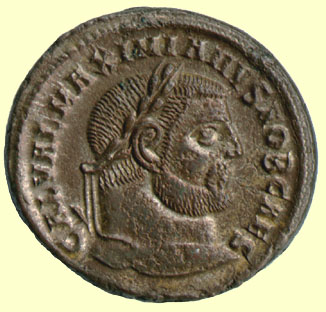 Contents -
Previous Article -
Next Article
Contents -
Previous Article -
Next Article
The Roman emperor Galerius was one of the four rulers under the system established by Diocletian called the Tetrarchy. From A. D. 293 to 305 Galerius was Caesar on the Danube frontier but was promoted to senior Augustus, or emperor of the East after Diocletian abdicated on May 1, 305. Galerius maintained his court at Thessalonika in what is now modern Greece.
During the period from A. D. 303 to 312, the Roman government under Diocletian and the Tetrarchy savagely persecuted the Christians. It is believed that Diocletian did not have much animosity towards the Christians before Galerius convinced him that they were dangerous enemies of the empire. At this time, there were many Christians in high political office, including some in the imperial family and the courts of the other three Tetrarchs.
After the abdication of Diocletian and Maximianus, Constantius Chlorus became Constantius I, Augustus in the West. The two Augusti in turn chose each chose a Caesar to replace them, and, in theory, the Tetrarchy should have provided a smoothly operating system of government for the Roman Empire. Galerius chose Maximinus Daia, who is better known as Maximinus II, and Constantius I chose Severus II. Without Diocletian's strong personality to keep them in line, the four men began to compete with each other for power and started squabbling amongst themselves.
Things came to a head in A. D. 306. Constantius Chlorus died at the Roman military town of York while campaigning in Britain after a short illness. The British legions immediately proclaimed Constantius' son Constantine emperor, threatening a rebellion that might destroy all of Diocletian's prudent work of reforming the Roman government. Galerius decided to recognize Constantine rather than risk civil war.
Later that year, the citizens of Rome rebelled after Galerius declared that no longer would they enjoy the privileged tax-exempt status that they had since Republican days. The rebels chose Maxentius as their emperor and Maxentius immediately asked his father to come out of retirement and join him on the throne. To prevent a return to the anarchy and constant civil wars of the Third Century Galerius called a peace conference at Carnuntum on the Danube frontier. Diocletian agreed to come out of retirement to preside over it. Maximianus was again forced to abdicate, Constantine was demoted to the rank of Caesar, and Maxentius was declared an outlaw and a public enemy. Licinius a long time friend of Galerius, was chosen for the position of Augustus in the West. Because Licinius had never served an apprenticeship as Caesar, both Maximinus and Constantine were quite angry. To appease them, Galerius made them both Augusti in 309.
In May of A. D. 311, Galerius died of what most sources describe as a "dreadful disease". The Christian writer Lactantius describes Galerius' body rotting and being eaten by maggots while he writhes in agony. This horrible demise proved God's justice, forcing the persecutor to acknowledge Him and end the persecutions a week before his death. Maximinus became Augustus in his place and moved his court to Nicomedia.
Go to next article on Constantius I
Go back to previous article on Emperor Maximianus